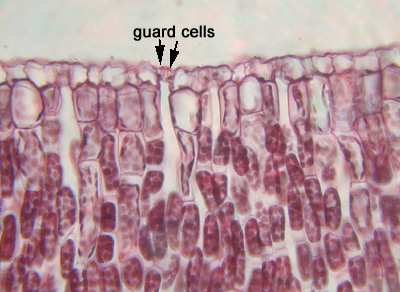HYDROPHYTE LEAVES
Hydrophytes must adapt to an environment with too much water and not enough oxygen. Submerged leaves have no stomates and a system of air cavities which retain the oxygen released during photosynthesis. Aerial leaves of hydrophytes resemble those of mesophytes while floating leaves may have large air chambers as in submerged leaves and stomates restricted to their upper surfaces. Vascular tissues may be reduced.
Nymphaea (water lily)
Nymphaea is not native to our area. You can find it however in many of the ponds including Beaver Lake in Stanley Park.
Leaf Cross Section
This is a section through the leaf. You can see that there are large intercellular spaces for aeration and buoyancy. Although it is not so clear in this image the stomata are found on the upper surface of the leaf. The chloroplasts are stained red. Note branched sclereids. What is their function? See Raven 7th, p. 563, Fig. 25-21; 8th, p. 595, Fig. 25-22.
The stomata are on the upper surface the water lily leaf. Why would this be important?
MESOPHYTES (there is no shortage of available water)
XEROPHYTES (dry habitat)
HYDROPHYTES (lots of water)
TRICHOMES AND LEAF APPENDAGES
LEAF MODIFICATIONS
BACK TO LEAF FRONTPAGE




